Inside the exhibition
Alternative Brains
There is a great diversity of minds and intelligences inhabiting the Earth: from human consciousness to the complex brains of octopuses, as well as the collective and liquid brains of social insects, such as ants or termites. In this “Inside the Exhibition”, Ricard Solé, an expert in Complex Systems and co-curator of the exhibition "Brain(s)", suggests six possibilities of alternative brains that we don’t find in reality and invites us to see how science might explain why they are not a part of the real world.
Original drawings and text by © Ricard Solé, co-curator of the exhibition “Brain(s)”.
The cognitive biosphere is occupied by a plethora of distinct life forms able to gather, process and create information, adapting to their environments in different ways. These diverse life forms include systems equipped with large brains. This is the case of mammals, including humans as one particular species along with primates, elephants, dolphins and whales. But we also find smaller brains in birds and octopuses that allow the organisms to display complex behaviour. These are examples of “solid” brains, with an architecture that is grounded in the development of a set of neurons which, once development has finished, occupy the same locations until they die. These neurons are linked with many others, defining a living web where the strength and nature of connections can change during the organism’s lifetime. But not all brains are solid.
The cognitive complexity of social insects, including ants and termites as major players, have evolved in parallel with solid brains. Their colonies achieve outstanding goals, including the construction of large, sophisticated nests. Here, the intelligence is not located in the individuals as happens with neurons and solid brains, it results from emergent phenomena. In this case, instead of neurons we have mobile agents that change their location and their interactions in time and space. The collective brains in insect societies are liquid. They are in fact one brain made of small brains, always in movement. But there are also liquid brains within our bodies: the immune system is made up of billions of cells of different kinds that protect us from pathogens and self-immune responses. This system has memory, can learn, and largely behaves as some kind of fluid neural web. Other kinds of minds can be found in non-neural organisms, such as Physarum moulds, which are in fact single giant cells able to perform complex computations.
What else is there? Is what we find in the biosphere all there is? Or are there instead potential alternative forms of cognition that are possible but that have not been generated by evolution? Could the architecture of our brains, formed by two connected halves, be different? Could plants with brains be a possibility? And if not, why not? Let’s take a look at six alternative possibilities that we don’t find in reality and see how science might explain why they are not part of the real world.
Brainy ants
It’s been said that ants aren’t very smart, and that seems to be true at least to some extent. Individual ants belong to a superorganism, a large-scale assembly that is able to perform outstanding achievements as a whole. Millions of ants can roll over the rainforest as a single mass like a massive predator. Leaf-cutter ants build enormous nests that include a fungus-growing factory inside them, thus developing agriculture as part of their exploitation of natural resources. But such success seems to involve a toll on the cognition of single ants. There seems to be a trade-off between individual and collective complexity: the more complex the society is, the less complex the individuals forming it. So, why we don’t observe “brainy ants”?
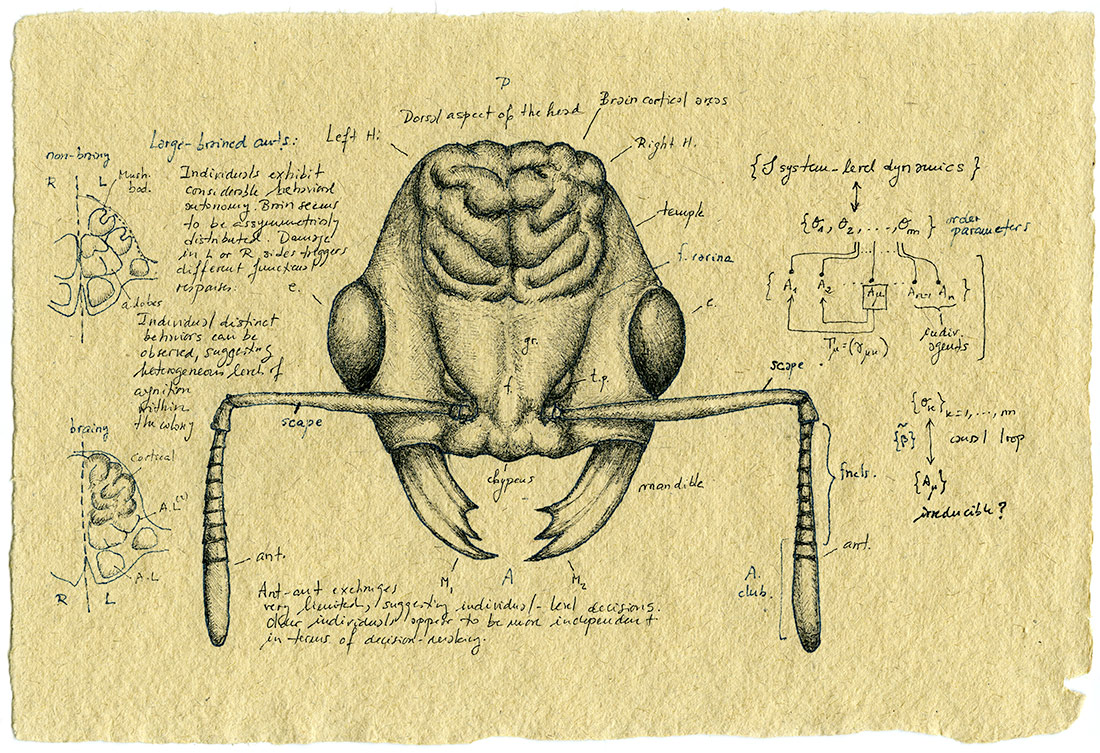 Brainy ants, Ricard Solé © Ricard Solé
Brainy ants, Ricard Solé © Ricard Solé
The possibility of a colony composed by many individuals carrying a large brain has appeared several times within the science-fiction literature. The Borgs in Star Trek are an example of such a society, where each individual is an advanced cyborg. An early precursor of this hive mind concept in sci-fi was the novel The first men on the moon, by H. G. Wells. There, the “selenites”, inhabitants of our satellite, are insectoid creatures that form a complex underground society and use advanced technology. Similarly, a collective consciousness also pervades the extra-terrestrial life forms that infect humans in the famous 1956 film by Don Siegel Invasion of the Body Snatchers. In this case, spores coming from outer space are able to grow into exact copies of humans (and their brains) that are replaced by a new member of the hive which lacks all emotions.
There is so far no established explanation for the absence of brainy ants. One possible reason for this lack of large individual brains within large ant colonies needs to be found in the so-called complexity drain hypothesis. This theory establishes that if higher-order complexity needs to be achieved, individual units will be simpler in order to facilitate the survival of the system at the lowest cost. This seems to be the case for individual cells within multicellular organisms: cells tend to be specialised and lack flexibility, and sometimes even lack a considerable amount of structural complexity, as is the case of red blood cells (which have lost almost everything and only transport oxygen). Simpler units make fluid exchanges among different parts of the whole possible, while their reduced cognition also makes them cheaper. If this idea is correct, no brainy ants are possible.
Brains like computers?
The human brain (and mammalian brains in general) has a characteristic organisation with a bilateral structure, with two hemispheres, right and left. These two parts are connected by the “corpus callosum”, a massive set of links that cross from one side to the other, as shown by the drawings of early anatomists. The brain is made up of 86 billion cells and displays several levels of organisation, from the micro- to the macro-scale. The brain is able to dream, imagine and create art and scientific theories. We cannot perform calculations as fast as a standard computer, which is the most popular metaphor for brains, but we are capable of building theories of the universe and mathematical theorems. We manage the most complex language, and we are time travellers: the capacity to deal with past and future are an intrinsic part of our minds.
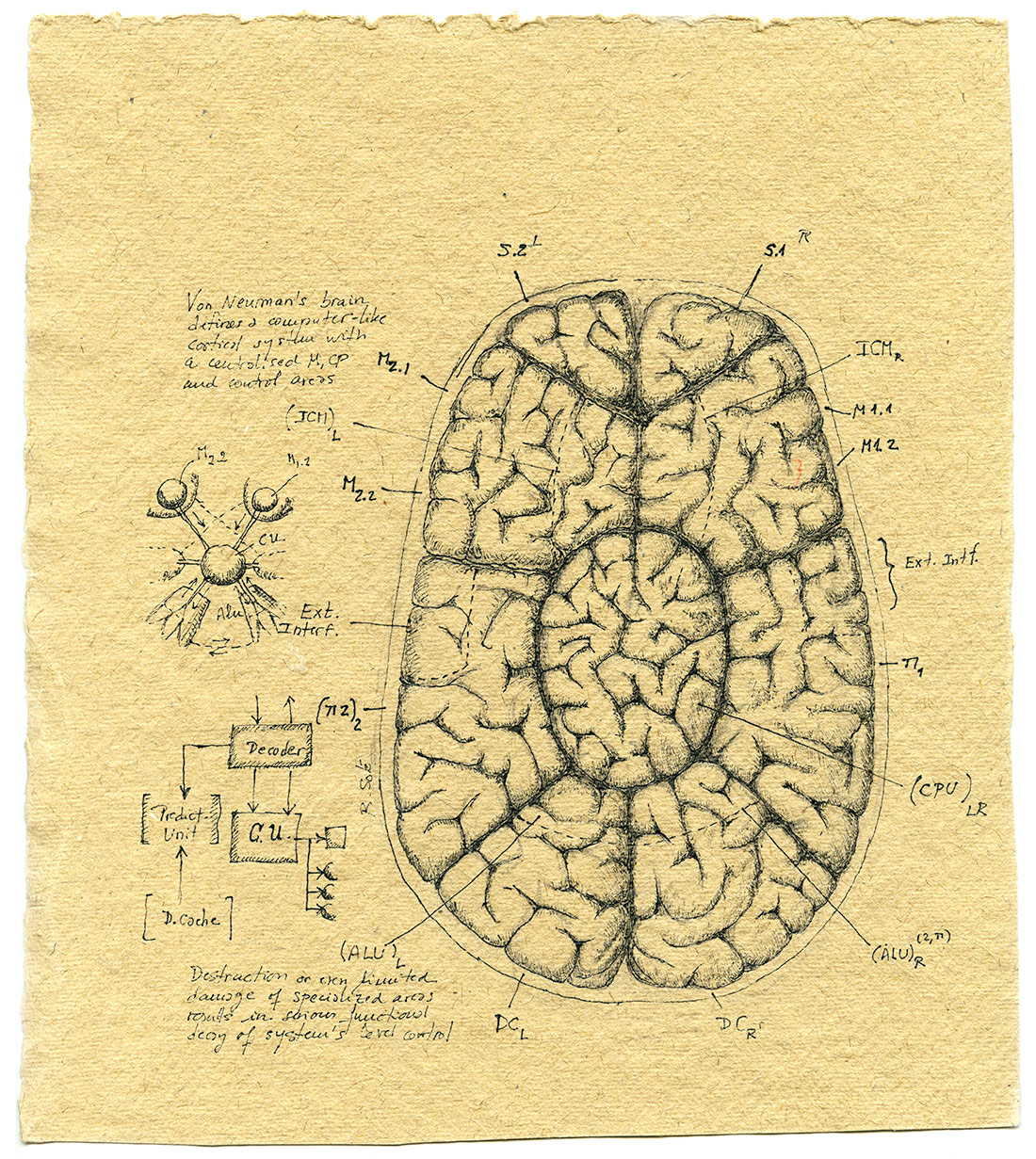 Brains like computers?, Ricard Solé © Ricard Solé
Brains like computers?, Ricard Solé © Ricard Solé
How far are apart our brains from the architecture of a computer? Very far. The architecture of most computers that we use nowadays is grounded in the vision of the polymath John von Neumann based on the previous work by engineers J. Presper Eckert and John Mauchly. The so-called von Neumann architecture conceives digital computers as sequential, input-output systems that include a central processing unit (CPU), a control unit, a memory unit that stores both data and instructions and an external storage unit. We could imagine an alternative brain where the cortex is segregated into several, anatomically distinct modules as shown in the previous drawing. In this alternative brain, a similar modular structure would be implemented, with memory and processing localised in well-defined areas.
This is not at all what we find in real brains, and there are many reasons for this. On the one hand, computers are designed by humans to perform calculations that involve crunching large amounts of numbers and require rapid execution. The input-output design and the logic of the von Neumann architecture are perfect for this goal and -as happens with many engineering designs- benefits from modular structure. Our brains also display some specialisations, as shown by the fact that damage to certain areas of the brain cortex produce a distinct impairment. Loss of language functions and lack of sight are just two examples. However, these are not real modules: all these functions are deeply interconnected with other areas, and integration is as important (if not more) than modularisation. The so-called brain connectome provides a cartography of such compromise between segregation and integration. Moreover, the brain is the result of tinkering: evolution has taken advantage of what is already there to create new structures. As a result, it is a combination of optimality and accidents that have been frozen in time.
Disordered brains
One important difference between brains and computers, as von Neumann himself realised, is that the former are highly reliable when faced with the loss of units, while the second are brittle. In his book The computer and the brain, von Neumann tried to explain this property. Would it be possible to design a computer that could keep going despite the failure of its units just like the brain? At that time, the first computers were very large, made up of thousands of vacuum tubes.
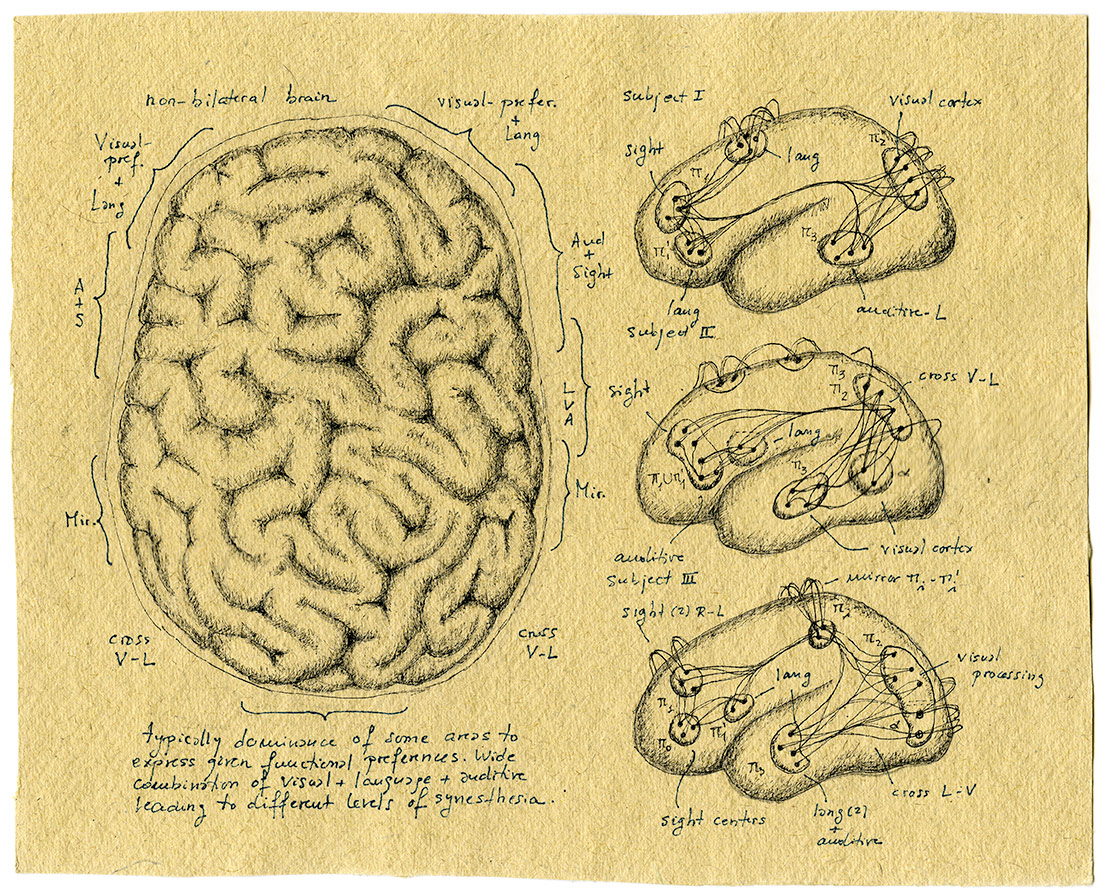 Disordered brains, Ricard Solé © Ricard Solé
Disordered brains, Ricard Solé © Ricard Solé
The failure of parts in the brain can be counterbalanced by its enormous plasticity. This is the case even when half of the brain cortex is removed to treat extreme cases of epilepsy: the missing areas and functionalities are safely reconstructed in the remaining hemisphere, as described by the neuroscientist and educationalist Antonio M. Battro in his book Half a Brain Is Enough: The Story of Nico. Could the brain be more plastic, perhaps lacking all specialised parts, and develop into a more amorphous system, where totally different connectomes grow in each individual? In the previous drawing we show this imaginary brain, with no hemispheres, thus defining a self-organising system, where the final architecture would be the result of path-dependent developmental and learning trajectories.
Is such a brain possible? Certainly not. Brains emerge in evolution as a result of different forces of selection, including movement. The so-called moving hypothesis posits that the active exploration of an organism’s spatial environment propelled the evolutionary trajectory that produced brains. Brains are prediction engines, able to forecast future changes in the environment. Which organisms are able to do so? Humans are just one species among the so-called bilaterians—animals with a well-defined lateral (left-right) symmetry. The ‘first’ brains were formed out of this principle and became powerful prediction machines. The requirement of sense organs (eyes in particular) and coordinated movements was strongly constrained by the bilateral design. A predictable developmental plan that creates the brains that we know makes it easy to create networks that channel the flow of information from sensors to actuators.
Octopus technology
Cephalopods, which include octopuses, squids and cuttlefish, have highly complex brains. The brains of octopuses provide an instance of convergent traits despite being invertebrates. Their neural apparatus evolved in parallel with the emergence of vertebrate brains, but they also display the characteristic multi-layered organisation. They also have a unique 8-fold extra neural cluster that autonomously controls the arms. To some extent, we can say that they have eight extra brains, each one controlling one arm. Because of their shape-shifting nature and distributed neural autonomy, these organisms have often been labelled “alien”. Not surprisingly, science fiction writers have gotten inspiration from these animals to depict extra terrestrial creatures.
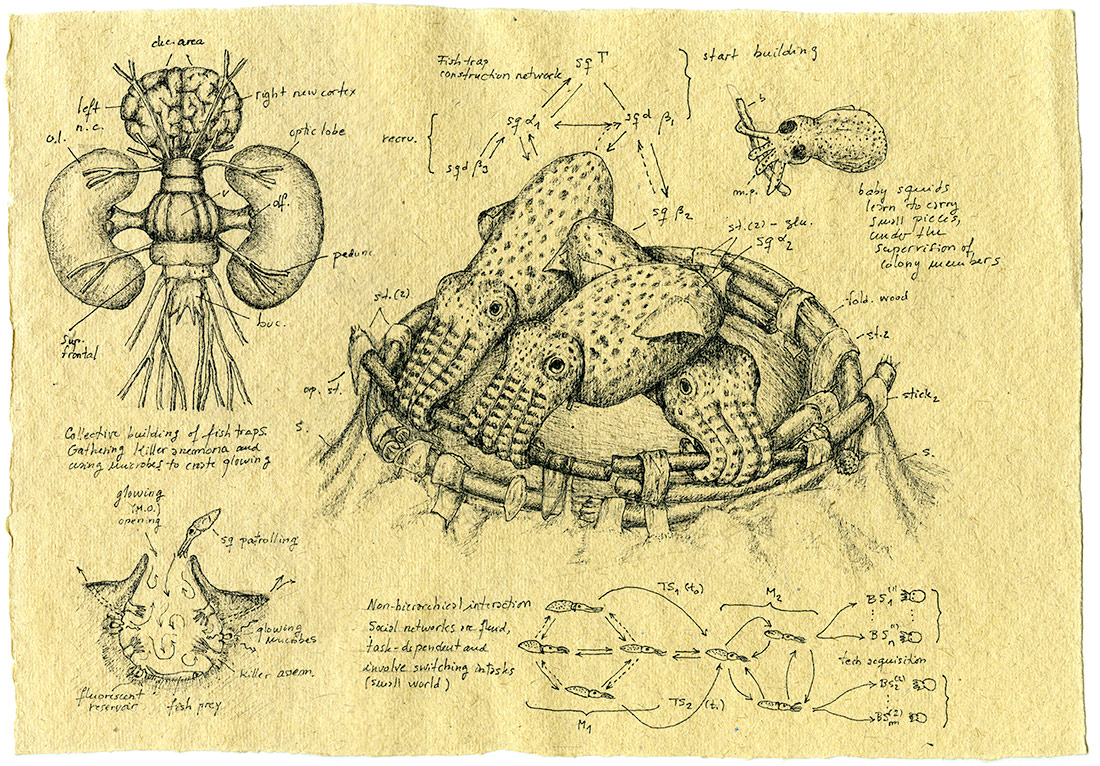 Octopus technology, Ricard Solé © Ricard Solé
Octopus technology, Ricard Solé © Ricard Solé
Octopuses are considered the most intelligent among invertebrates, and their cognitive power is illustrated by many well-known experiments that reveal their capacity for solving problems. They display behavioural plasticity, can deal with complex tasks, learn from experience and are also known to have a limited capacity for tool use. Although they also use shells as shelter and manipulate objects, they have not developed an extended mind. Why?
The drawing above depicts a group of squid working together to build a fish trap. Such a scenario would require social interactions that do not seem to be shared among cephalopods. Moreover, a unique feature of this group of organisms is that they have very short life spans with an average of two years only. What would happen if octopuses had evolved to live longer and develop stronger social ties? Could an octopus civilisation emerge out of this?
Plastic-based collective cognition
Societies of organisms are known to compete with humans all over the planet. Social insects in particular are outstanding ecosystem engineers: they are builders and landscape transformers over vast scales. But there are other kinds of associations that involve the cohesive combination of multiple organisms working together and forming a complex organism, as occurs with a singular inhabitant of the oceans: the so-called Portuguese man-of-war. The units of the colony are identical clones but specialised in different functions, such as reproduction or hunting, and include a large floating bladder that is visible on the surface and allows the colony to navigate following the winds. Altogether, they work as a single individual.
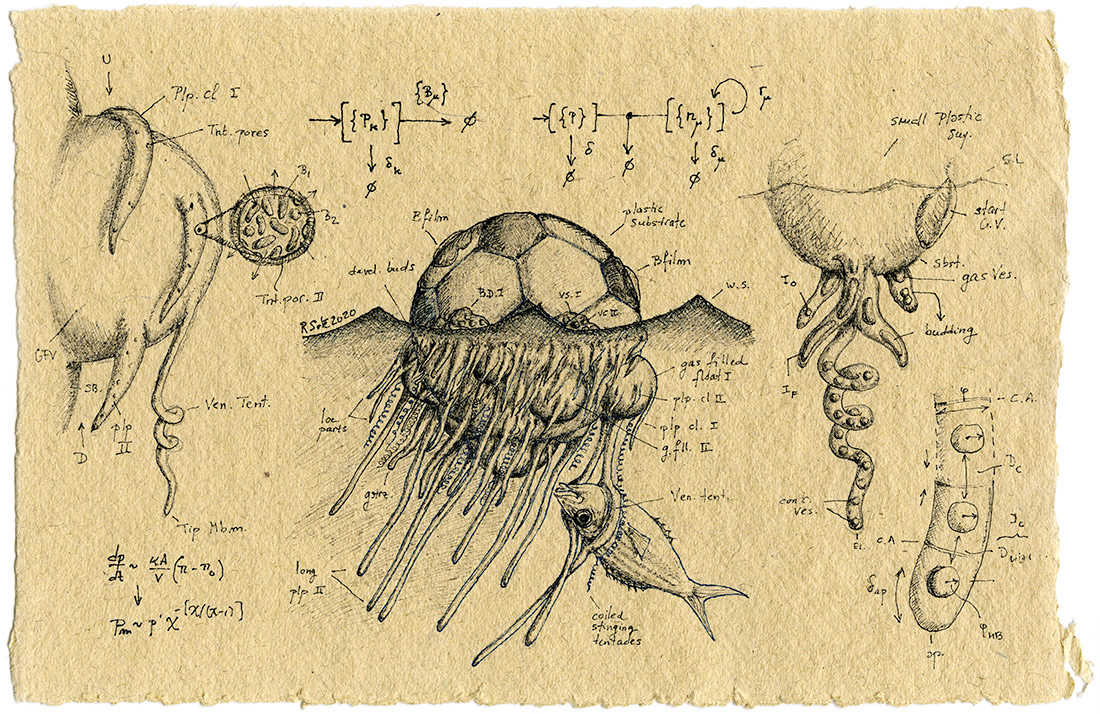 Plastic-based collective cognition, Ricard Solé © Ricard Solé
Plastic-based collective cognition, Ricard Solé © Ricard Solé
But the ocean is also inhabited by an undesirable outcome of the Anthropocene: plastic debris. Plastic objects have been accumulating over decades, becoming a major threat to marine diversity. Microplastics make up most of this, but large objects, from bottles to balloons are there too. As a result of the interactions between plastic and marine life, a novel ecosystem has been formed: the so-called Plastisphere. Nowadays, this is a rich ecosystem that includes a large number of species that take advantage of plastic as a substrate to attach and remain close to the surface or even as a source of energy.
Could a new class of organisation based on the interaction between plastic objects and groups of organisms (perhaps belonging to different species) end up in a “synthetic” Portuguese man-of-war as shown in the above drawing? Given the long-life span of plastics, stability could be an advantage to provide resilience to such an assembly. However, this evolutionary path might be difficult to actually follow. The evolution of organisms, including colonial life forms, implies the development of specialisations and the result of each evolutionary step is heritable. The propagation of complexity is guaranteed by the replicative nature of life. For our synthetic alternative, several chance events would instead need to occur before a suitable colony might become a unit, and additional mechanisms should evolve to propagate the collective into new plastic items. This might take an extremely long time to become a reality.
Neural plants
Are plants intelligent? This is a very controversial issue. If the moving hypothesis is correct and brains are largely the result of a selective pressure to deal with changing environments, plants seem to be out of the equation. Because of their capacity to gather energy from the Sun, they are highly confined to remain in a given location. They are called sessile organisms, and the advantage of not needing to search for energy might have largely constrained their potential to develop complex cognition
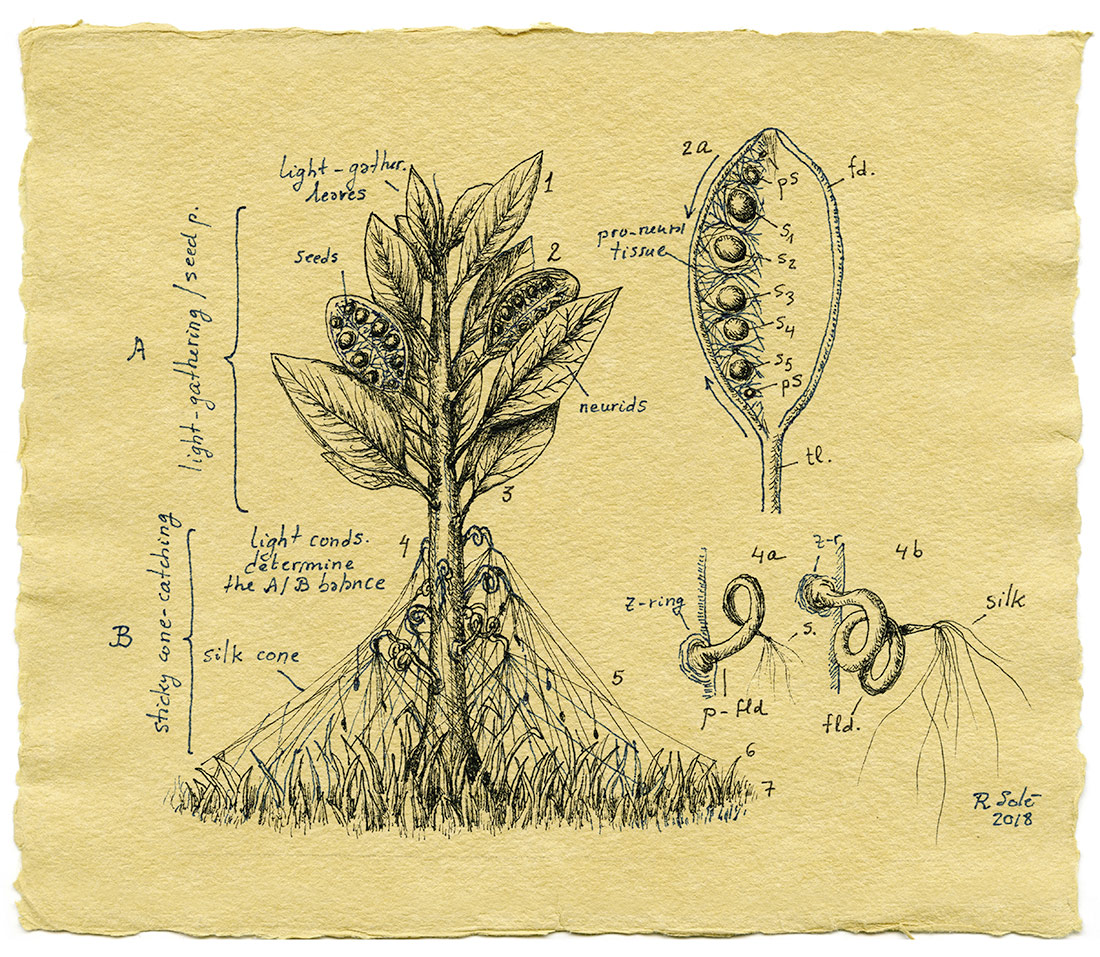 Neural plants, Ricard Solé © Ricard Solé
Neural plants, Ricard Solé © Ricard Solé
Some authors claim that there are several features of plant architecture and physiology that recall certain features of neural systems. Plants do not have neurons, but they use a rich chemical communication system, are capable of limited learning and memory and exhibit remarkable cooperative traits. But no brains. Could evolution generate neural plants?
In the last drawing we illustrate this with an imaginary plant, where seeds are connected to neurons that would provide fast detection mechanisms that could, for example, make seeds jump into animals walking around at the right distance. We could also think of alternative ways of acting as predators. Carnivorous plants, which tend to live in some nutrient-poor, waterlogged environments, are able to catch insects that provide required minerals that might not be present in their habitats. Could such predatory behaviour be expanded using an extended mind, for example, as spiders do? We could imagine a neural plant able to create a web that could attract and capture insects or even small rodents and birds. Once dead, a large chunk of organic matter would be available. Could such an alternative plant occur in an alternative biosphere? We cannot answer this question, but we must take into account that plants have been the greatest transformers of the planet and have been conquering (and creating) landscapes over millions of years since they emerged from marine habitats and adapted to the terrestrial context. Over this long-time scale, a huge diversity of designs and adaptations have evolved. None of them are close to our alternative picture. Perhaps the energy from light is enough, and too cheap for plants to invest in cognition.
Brain(s)
27 July — 11 December 2022
The human brain is the most complex object we know of and the one that raises most questions in the fields of both science and philosophy. "Brain(s)" looks at how, throughout history, art, science, and philosophy have studied and represented this fascinating organ.
